This is a mirror for the page https://nis.orissalinks.com/.
Blogs and other coverages on the NIS/IISER in Orissa issue and keeping track of NISER Bhubaneswar
September 17th, 2023
(Last updated: January 31, 2024)
Universities and University like Institutes
1. IIT Bhubaneswar
2. NISER Bhubaneswar
3. AIIMS Bhubaneswar
4. XIM University Bhubaneswar
5. Utkal University
6. OUAT
7. National Law University
8. IIIT Bhubaneswar
9. AIPH University
10. SOA University
11. KIIT University
12. CUTM University
13. Sri Sri University
14. Birla Global University
15. Ravenshaw University
16. Rama Devi University
17. Sri Jagannath Sanskrit University
18. Utkal University of Culture
19. KISS
20. Odia University
21. ASBM University
22. CV Raman Global University
23. Jagaduru Kripalu University – bill passed, construction happening, not functional yet
24. Madhusudan Law University
25. Odisha University of Technology and Research.
26. Odisha University of Health Sciences
27. DRIEMS, Cuttack
28. Silicon University
Campuses of Universities HQed elsewhere
1. ICT Mumbai – IOC Campus Bhubaneswar
2. Central Sanskrit University – Sri Sadashiva campus, Puri
3. Cuttack campus of Maulana Azad National Urdu University, Hyderabad
4. CSIR IMMT – Bhubaneswar
5. RIE Bhubaneswar – Under NCERT which is now a deemed University
6. IIMC Dhenkanal (IIMC is now a deemed university)
7. Bhubaneswar Campus of NMIMS University , Mumbai – land has been leased to SVKM society for this and construction plan is being made; not functional yet
The following should be part of deemed universities.
1. IITTM Bhubaneswar
2. CIPET Bhubaneswar
The following may be established as universities .
1. Radhanath Education University
2. Sports and Physical Education University
3. Veterinary University
(See https://www.orissalinks.com/archives/6243 for the time line of higher education institutions in Odisha.)
April 30th, 2018
(Thanks to Prof. Moshe Vardi of Rice University for this pointer.)
This is based on the data made available at http://acarem.hse.ru/data where the faculty compensations (both salaries and perks such as housing) are compared on a PPP (purchasing power parity) basis in 26 countries. Following are some bullet points based on that data.
- In terms of academic salaries of entry level faculty at public universities the list with the per month salary in PPP US Dollars is: Canada (5733), Italy (5029), US (4950), Germany (4885), Norway (4491), UK (4077), India (3954), Australia (3930), South Africa (3927), Israel (3525), Netherlands (3472), Saudi Arabia (3457), Argentina (3151), Japan (2897), Malaysia (2824), Nigeria (2758), Czech Republic (2562?), Turkey (2027), France (1973), Columbia (1965), Brazil (1858), Mexico (1336), Latvia (1087), Kazakhstan (1037), Ethiopia (864), Russia (433), Armenia (405), China (259).
- In terms of academic salaries of top level faculty at public universities the list with the per month salary in PPP US Dollars is: Canada (9485), South Africa (9330), Italy (9118), Saudi Arabia (8524), UK (8369), Malaysia (7864), Australia (7499), India (7433), US (7358), Netherlands (7123), Germany (6383), Israel (6377), Nigeria (6229), Norway (5847), France (4775), Japan (4604), Brazil (4550), Argentina (4385), Columbia (4058), Czech Republic (3967), Turkey (3898), Mexico (2730), Latvia (2654), Kazakhstan (2304), Ethiopia (1580), China (1107), Russia (910), Armenia (665).
- In terms of ratio of monthly salaries to GDP per capita per month for entry level faculty at public universities: Ethiopia (130%), Nigeria (116%), India (110%), South Africa (45%), Argentina (23%), Columbia (23%), Malaysia (20%), Turkey (19%), Brazil (18%), Italy (16%), Canada (13%), Germany (12%), Israel (12%), Saudi Arabia (12%), UK (11%), US (11%), Czech Republic, Mexico (10%), Australia (8%), Japan (8%), Netherlands (8%), Armenia (7%), Kazakhstan (7%), Norway (7%), France (6%), Latvia (6%), China (4%), Russia (2%).
- In terms of ratio of monthly salaries to GDP per capita per month for top level faculty at public universities: Nigeria (262%), Ethiopia (238%), India (207%), South Africa (107%), Malaysia (56%), Columbia (47%), Brazil (43%), Turkey (36%), Argentina (32%), Italy (30%), Saudi Arabia (29%), Canada (22%), Israel (22%), UK (22%), Mexico (21%), Germany (17%), Australia (16%), Kazakhstan (16%), Latvia (16%), US (16%), China (15%), Czech Republic (15%), Netherlands (15%), France (14%), Japan (13%), Armenia (12%), Norway (9%), Russia (5%).
- Housing:
- Provided to all by law: India, Latvia, Nigeria
- Widely used to attract best faculty: China, Saudi Arabia
- Important part of contract negotiations: Kazhakstan, Turkey
- Not influential in contract negotiations: Canada, Ethiopia, Japan, South Africa, UK
- Not offered: Rest
- Retirement funds
- Not offered: Kazakhstan
- Widely used to attract best faculty: UK, China, Canada
- Provided to all by law: Rest (includes India)
One can also use the numbers in http://www.bbc.co.uk/news/magazine-17543356 to do further comparison. For example, the average income in India is $295/month in PPP dollars. So an entry level faculty in a public university in India earns $3954/295=13.4 times of an average Indian. In contrast, an entry level faculty in a public university in US earns $4950/3263= 1.52 times of an average American.
June 21st, 2012
Following is from a PTI report in zeenews.
The proposed innovation universities in the country would be supported by research councils, which would not only identify potential areas of research but also extend advisory services in other areas.
Every university for research and innovation will have such a council headed by a director. These varsities shall present its report annually highlighting its achievements on their website.
The proposed innovation universities, a Bill of which was introduced in Parliament last week, are to be set up during the 12th Plan Period.
The hallmark of the legislation is that each university would focus on one area or problem of significance to India and build an eco-system of research and training around different related disciplines.
In keeping with this objective, each of the council of the university concerned shall interface with research funding organisations, industry and civil society to identify potential areas for research in areas of enterprise.
Besides, the council will assist the teachers in obtaining funding from external sources for research projects prepared by them, according to the provisions of the Universities for Research and Innovation Bill, 2012.
The Bill seeks to set up the universities both in the public as well as the private sectors.
As per the provisions, each of these universities would offer exposure to an international classroom environment, with a minimum of 50 per cent of the students from India.
Each of the research council will be headed by a director and members, the strength of which would be specified by the board of governors of the university concerned.
The council will also provide for incubation of applications emerging from research undertaken in such university.
Importantly, it shall make provisions for research and advisory service for which it would enter into agreement with other institutes, industry, civil society and other organisations and enable the results and benefits of research to be disseminated to the public.
According to the Bill, the research council shall present its annual output on its website three years after the establishment of the university and each year thereafter.
Each of the university would have autonomy in matters of academics, faculty, personnel and finances administration.
May 28th, 2012
The 12th plan working group report on Sports and Physical Education recommends the establishment of four regional centres of LNUPE and 5 new sports and physical education universities or physical education colleges. Odisha must vigorously pursue the central government and the planning commission to get one of the proposed 5 sports and physical education universities.
In this regard, please send an email to the Odisha CM at cmo@ori.nic.in with content such as given below:
Dear Esteemed CM:
The 12th plan working group on Sports and Physical Education has recommended in their report at http://planningcommission.nic.in/aboutus/committee/wrkgrp12/hrd/wg_repsports.pdf that "for meeting the increasing demand of Physical Education Teachers and producing quality PETs, at least four regional centres of LNUPE and 5 new sports and physical education universities or physical education colleges should be opened during 12th
Plan. "
Kindly pursue with the central government regarding having one of these universities in Odisha.
Sincerely,
Following are some rationale behind pursuing a Sports and Physical Education University. Please have a look at it at your leisure.
While promoting sports, besides providing good facilities (hostels, stadiums, turfs), what is most important is that the athletes are provided with opportunities to pursue some recognized degree/diploma/certificate of study so that they have alternate avenues of employment. For example, consider the story in http://www.indiablooms.com/SportsVideoDetails/sportsVideoDetails180312f.php.
Following is an excerpt from that story.
Renowned national woman footballer Jhilli Munda, who has represented India at international and national events in several tournaments, is bearing the brunt of acute poverty and she is forced to roll beedis to earn her bread and butter.
It is well known that among the athletes that join the sports hostels, only a few make it to the state and national teams and of them only a few get appropriate jobs. What happens to the rest? It is sad to read about Jhili Munda’s story above. The point is until and unless we make sure that kids pursuing a career as an athlete have a way to make a living we can not significantly improve the sports scenario in Odisha and India. Now how do we make sure that *all* kids pursuing a career as an athlete have a way to make a living.
The way to do that is to provide them with some *relevant education* in parallel with their athletics training such that even if they do not make it to the top in sports, they can get a good job and make a living. What are some of the relevant educational avenues and programs?
Some of them are:
- Physical training
- Coaching in various sports
- Physiotherapy
- Sports medicine
- Exercise Physiology
- Sports Psychology
- Sports Biomechanics
- Sports Management and Mass Communication
- Health Sciences & Yoga
- Sports Massage
- Grounds Management
- Health and fitness management
- Sports journalism
- Sports photography and
- Sports commentary.
Some of these courses are offered at the three established institutions in India:
In the 2011-12 budget there was mention of the following *new* initiatives:
- Rajiv Gandhi National Institute of Youth Development in Tamil Nadu: With a 2011-12 budget allocation of 10.8 crores (2010-11: 9.9 crores)
- Laxmibai National Institute of Physical Education – NE area and Sikkim Initiative: With a 2011-12 budget allocation of 15 crores (2010-11: 3 crores)
In the 2012-13 budget (
http://indiabudget.nic.in/ub2012-13/eb/sbe106.pdf ) there was the mention of the following *new* initiatives:
- 7. Rajiv Gandhi National Institute of Youth Developmentin Tamil Nadu has a budget of 18.9 crores.
- 28. National Institute of Sports Science and Sports Medicine 5 crores
- 29. National Institute of Coaching Education 5 crores
Note that none of the above are in the eastern part of India and none are in the traditional tribal areas of India.
The 12th plan has a working group on Sports and Physical Education. They have a report at http://planningcommission.nic.in/aboutus/committee/wrkgrp12/hrd/wg_repsports.pdf . In that report the following is mentioned.
5.15 It has been recommended that for meeting the increasing demand of Physical Education Teachers and producing quality PETs, at least four regional centres of LNUPE and 5 new sports and physical education universities or physical education colleges should be opened during 12th Plan. An outlay of Rs. 900 crore on this account during 12th Plan is projected.
Thus we should vigorously pursue the establishment of a National Sports Institute/University in Odisha that not only offers training in the sports Odisha excels in (Hockey – mens and womens, Football, Rowing, etc.) but also offers the above mentioned programs so that every athlete of Odisha is able to simultaneously pursue a certificate/diploma/degree in one of the above disciplines and is able to make a decent living.
Considering that Sundergarh and Rourkela area is the hotbed of Odisha athletics (mainly Hockey) and it is a tribal district, it would be good to locate the proposed National Sports Institute/University in Sundergarh/Rourkela. It may have branches in Kendrapada and Bhubaneswar to cater to the women footballers of Kendrapada and other sports persons in Bhubaneswar/Cuttack. Moreover the university in Sundergarh/Rourkela can also cater to athletes in Jharkhand.
The recent election of Mr. Dilip Tirkey as a Rajya Sabha MP can be seen/argued as an indication that the Odisha government is serious about promoting sports in a wholesome way, with particular attention to adivasis.
May 1st, 2012
Following is an excerpt from a report in Hindustan Times.
Higher education in the country is set to get a boost with the HRD ministry finalising plans worth Rs. 80,000 crore inorder to improve access to colleges and universities.
The UPA government has embarked upon an ambitious plan to double the gross enrollment ratio (GER), from present around 17% to 30% by the year 2020. For this, there would be a need of several new universities and colleges across the country.
HRD minister Kapil Sibal on Wednesday told Lok Sabha that 200 new universities and a degree college in each district of India will be opened in the next five years. “We have asked for Rs. 20,000 crore for opening new universities in the 12th plan,” he said.
In addition to new institutions, many of the existing colleges will be upgraded either into universities or autonomous colleges having powers to award degrees.
The budget for revitalising the higher education will be Rs. 80,000 crore, the biggest ever allocation for higher education.
A large amount of this money will be awarded to state governments to improve higher education in rural areas. This, by increasing the Central government share in higher education funding to the states.
As of now, the Centre shares just 35% of the cost of starting a new higher education institution. In the 12th plan (2012-17), Sibal said, the government proposes to increase the Central share to 65% and 90% for the north-eastern states.
This, according to the ministry, will give an incentive to the state governments to submit proposals for starting new higher education institutes. Many state governments have been reluctant to seek funds from the Centre because they had to assure 65% funds to start the project.
April 26th, 2012
Following is from a report in Times of India.
The report of the steering committee on health for the 12th five year plan (incorporating reports of all working groups and deliberations in Committee meetings) has suggested opening of four new prototypes of premiere All India Institute of Medical Sciences ( AIIMS) in addition to the eight already approved.
… Union health ministry is in the process of constructing six AIIMS-like institutes in Patna, Raipur, Bhopal, Bhubaneswar, Jodhpur and Rishikesh at a cost of Rs 847 crore each, up from Rs 332 crore that was originally estimated. There are expected to be ready by July, 2012.
The Planning Commission has given approval to two more AIIMS-like institutes in Uttar Pradesh and West Bengal. …
With 26 medical institutions have been approved for upgrade, the panel has said an additional 30 medical colleges established at least 20 years ago be identified for support through Pradhan Mantri Swasthya Suraksha Yojna.
“Other medical colleges, in private or voluntary sector may also be considered for upgrade and strengthening for starting new postgraduate disciplines and increasing post-graduate seats,” the report says.
In Odisha, as per the timeline, SCB medical college in Cuttack was established in 1944, VSS in Burla was established in 1959 and MKCG in Berhampur was established in 1962. All three of them satisfy the above mentioned criteria of being established 20 years ago. Considering that none of the 26 approved upgrades are from Odisha, and 4 states currently are approved for both new AIIMS-like institutes as well as upgrades (WB,Bihar, MP, UP) the Odisha government should push for all three of its existing government medical colleges to be upgraded during the 12th plan.
December 31st, 2011
The website of this summit is http://www.ficci.com/past-Events-page.asp?evid=20665. Following are excerpts from the press release on Dr. Montek Ahluwalia’s speech.
Inaugurating FICCI Higher Education Summit 2011: Strategies for Expansion in Higher Education in India’, Mr. Ahluwalia said, “The challenge before planners, policy makers and educationists, both in the public and private sector, was of producing world class Indian universities that could be counted in the top 200 rating list.” In the next 20 years we must see a significant number of educational institutions in that category, he declared.
Mr. Ahulwalia also underlined the need to lend an international flavour to Indian universities by inducting international faculty. This would not happen unless the government removes the restriction on employment of international faculty, he said.
For higher education, the 12th Plan objective was expansion, equality of access and excellence. The aim was to raise the gross enrolment ration from the current level of 15 per cent to 30 per cent over the next 15 years. “Expansion of higher education has to be balanced with equality of access, especially for those living in areas where educational institutes did not exist,” he said.
Following are excerpts from the press release on Sam Pitroda’s speech.
Addressing the FICCI Higher Education Summit 2011, Mr. Pitroda said, “Higher education reforms are essential if the nation is to meet the serious challenge of skill shortage that will not allow the economy to grow at 8-10 per cent annually. While many of the recommendations of the National Knowledge Commission are in the process of being implemented, we are waiting for the government to act on the recommendations retailing to reform of higher education.”
“The debate on what needs to be done ought to be over, the time now is to focus on action,” he said and added that “the Bills have already been drafted but none of them have been tabled in or passed by Parliament.”
Mr. Pitroda’s concern found an echo in FICCI President, Mr. Harsh Mariwala’s suggestion that although education continues to be a priority sector during the Twelfth Plan, unless the reform agenda initiated by the Ministry of Human Resource Development in the 11th Plan is carried forward within a stringent timeframe, the demographic dividend of a young population could become a demographic disaster for India as well as the world.
Mr. Mariwala hoped that the Foreign Education Providers’ Bill; Unfair Practices Bill; Tribunal Bill and the Accreditation Bill will be passed in the coming winter session of the Parliament and the National Commission for Higher Education and Research (NCHER) Bill 2010 and Innovation University Bill will be introduced in the winter session of the Parliament. The delay in implementation of the reforms is a serious impediment for the economic development of the country, he said and added that FICCI earnestly urges the political leadership to take cognizance of this fact.
Mr. Pitroda said that the government was creating a US$ 5 billion National Knowledge Network (NKN) which is expected to be ready in about nine months. The network would be a state-of-the-art multi- gigabit pan-India network for providing a unified high speed network backbone for all knowledge related institutions in the country. It would facilitate the building of quality institutions with requisite research facilities and creating a pool of highly trained professionals. The NKN will enable scientists, researchers and students from different backgrounds and diverse geographies to work closely for advancing human development in critical and emerging areas.
Following are excerpts from a report in Chronicle of Higher Education.
Mr. Sibal has said that private participation in higher education must be encouraged, and conference attendees agreed that if the government hopes to reach its goal of sending 30 percent of young people to college, both private and public participation are needed. The challenge, as always, is in weeding out the low-quality operators.
"The public perception of private higher education is in a range," said Montek Singh Ahluwalia, head of India’s Planning Commission, a top government policy-making body. "Many are good, but there is a problem of those not-very-good ones."
Mr. Ahluwalia argued that supply and demand will eventually eliminate the bad actors, but others disagreed.
"It will be difficult to weed them out," said M. Anandakrishnan, head of the Indian Institute of Technology’s Kanpur branch. Because there is more demand than supply, he said, it will take time for stakeholders to make discerning choices.
Another delegate, Sachi Hatakenaka, a British-based education researcher, argued that "private sector growth is good for quantity but not for quality."
… Still, said Mr. Agarwal, the next round of government higher-education planning will focus more on expanding capacity at existing institutions rather than adding new universities.
Some private players were hopeful that the government will look to the private sector more as an ally than an adversary in coming years.
November 16th, 2011
Following are excerpts from a report in dnaindia.com.
In order to bring down the shortage of doctors and improve healthcare services at the minutest level, the government is planning to have medical colleges in each district.
It has plans to convert district hospitals into training institute the paramedical personnel as well.
Besides, the government also plans to integrate AYUSH doctors and have capacity building programmes for other traditional healthcare providers such as Registered Medical Practitioners (RMPs) and Traditional Birth Attendants (TBA) so that traditional care practices and local remedies are encouraged.
… As of now medical colleges are concentrated in only 193 districts of the country … The rest 447 districts do not have any medical college.
Against 335 colleges, there are about 319 Auxiliary nurses and midwives (ANM) training schools, 49 health and family welfare training schools and only 34 LHV (Lady Health Visitor) schools.
The present doctor patient ratio 0.6 per 1000 while the ratio of health workers (including midwives, nurses etc) is 2.5 per 1000.
“To fill the gap in training needs of paramedical professionals, the 12th Plan proposes to develop each of the district hospitals into knowledge centres, and 4,535 CHCs into training institutions,” says the Planning Commission report.
Odisha with its 30 districts will greatly benefit by this plan. In Odisha only 4 of its districts currently have medical colleges: they are Cuttack, Khorda, Sambalpur and Ganjam. The 26 districts in Odisha that do not yet have medical colleges are: Angul (*), Boudha, Bhadrak, Balangir, Baragarh, Balasore, Deogarh, Dhenanal, Gajapati, Jharsuguda, Jajpur, Jagatsignhpur, Keonjhar, Kalahandi (*), Kandhamal, Koraput, Kendrapada, Malkangiri, Mayurbhanj, Nawarangpur, Nuapada, Nayagarh, Puri, Rayagada, Subarnapur, Sundergarh (*). Among these 26, private medical colleges are under construction in Angul (by MCL and NTPC), Kalahandi (WODC), and Sundergarh (in Rourkela by Hi-Tech).
August 30th, 2011
I hope this is not all that Odisha is asking.
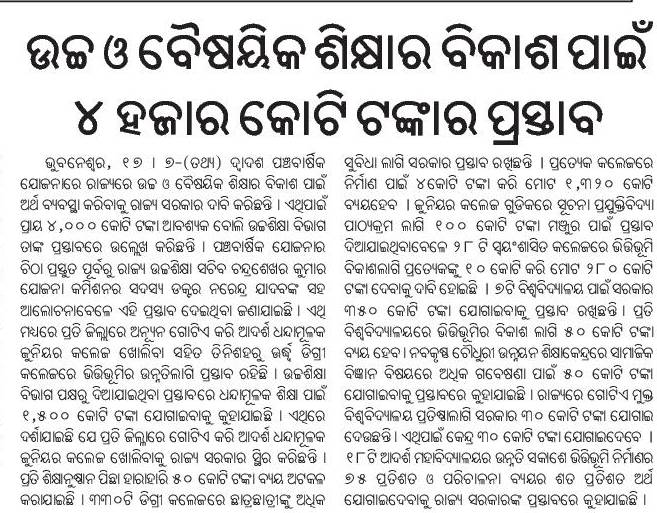
July 20th, 2011
Updates on July 19 2011:
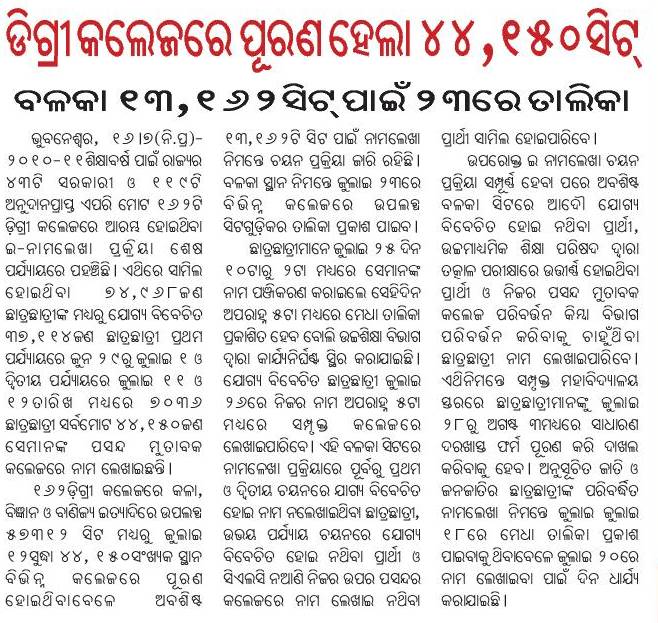
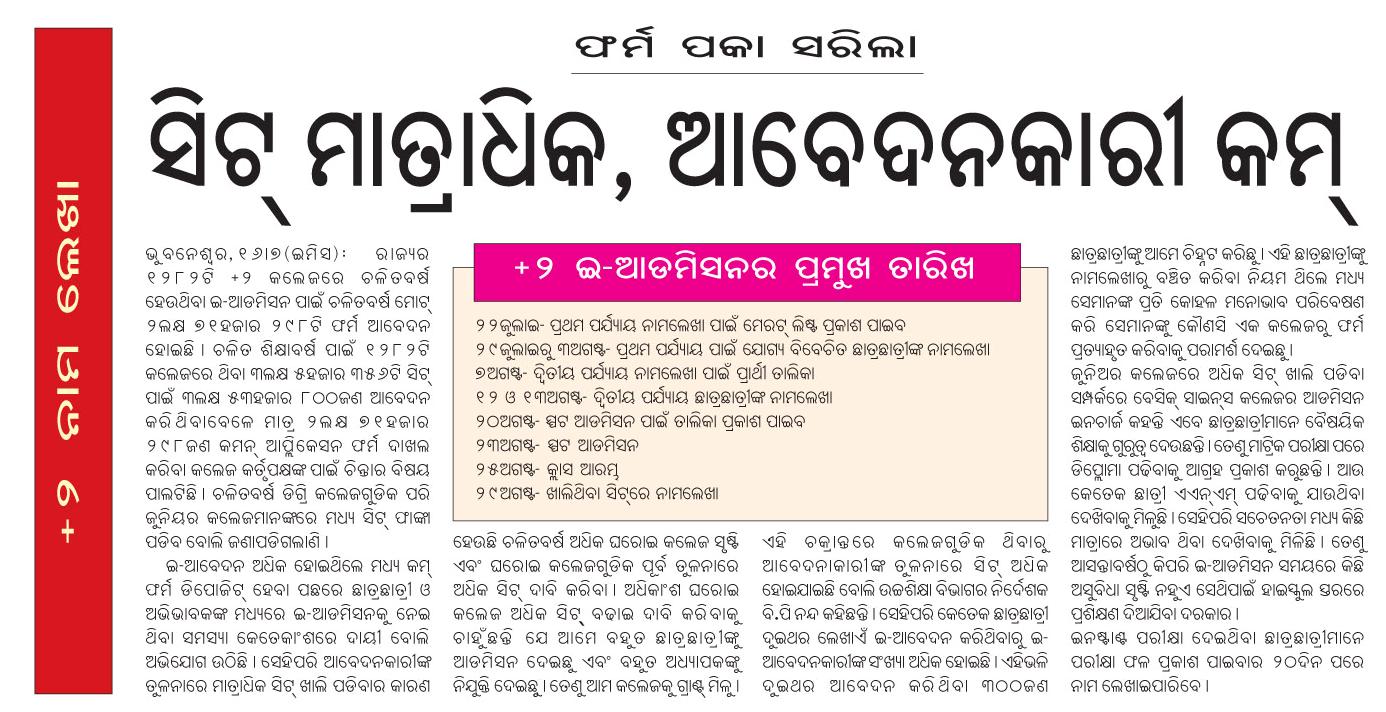
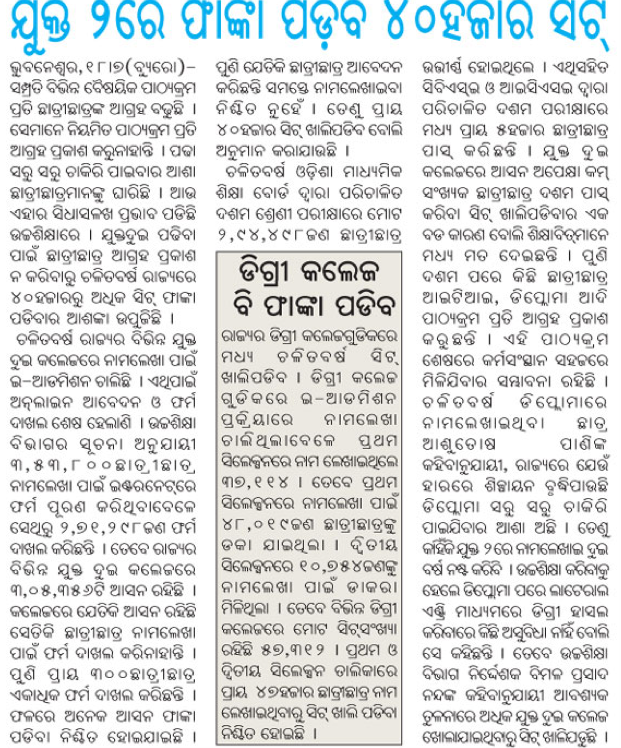
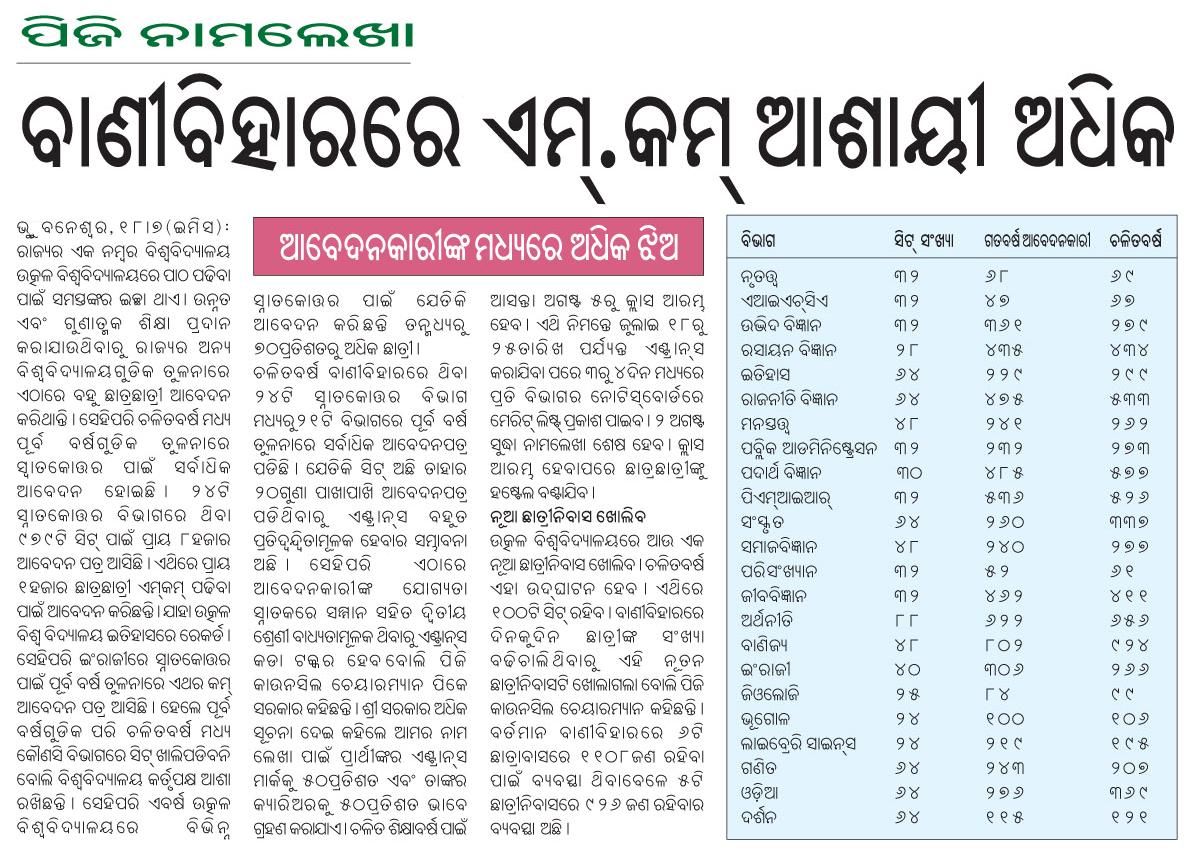
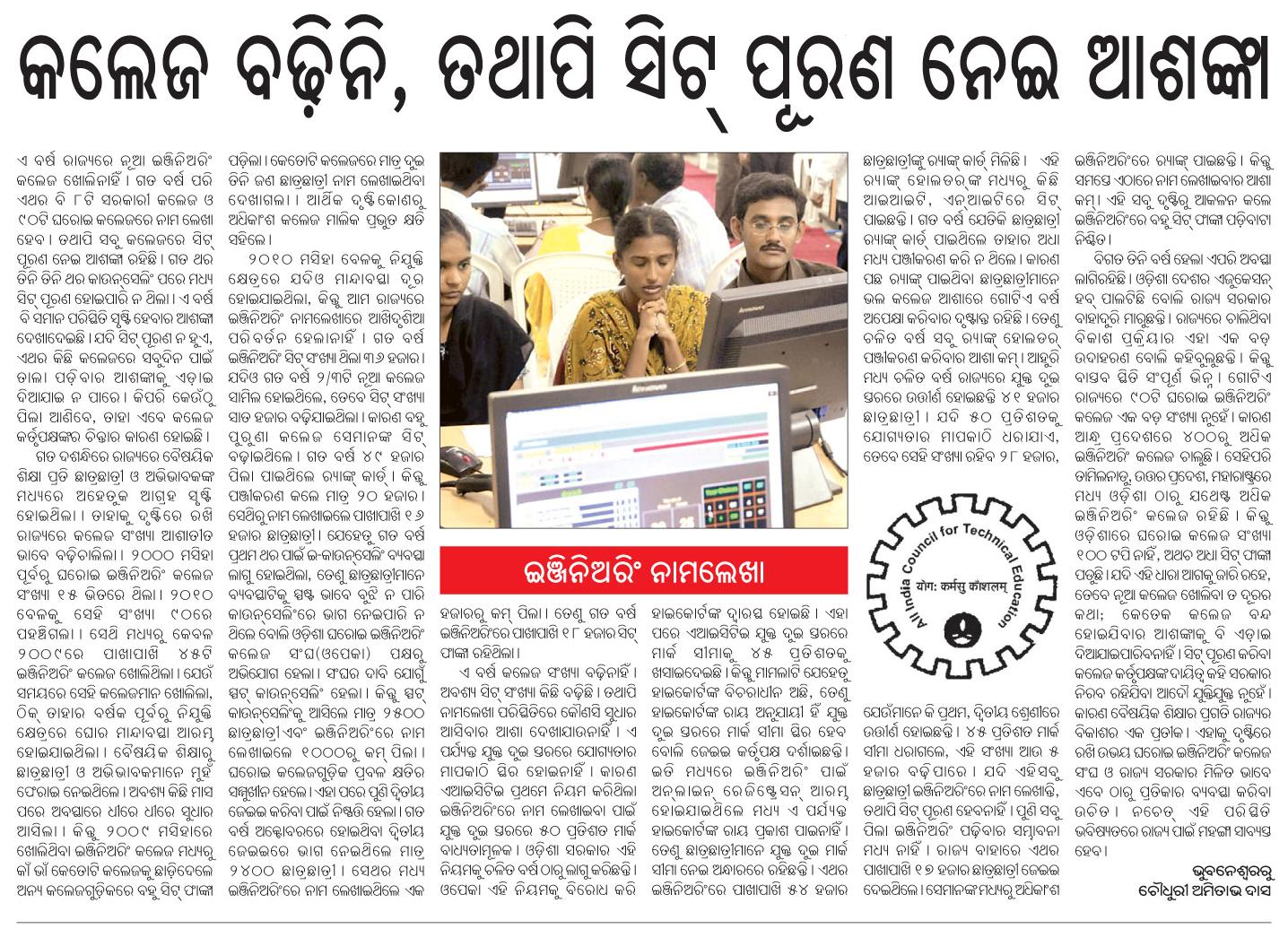
Article started on June 25 2011:
Following are some numbers related to how many students pass Matric exam, the number of seats and colleges available at the plus 2 level, and the number of seats and colleges available at the degree level. (We don’t have all the numbers yet. So this is a work in progress.) Several of these numbers are from http://dheorissa.in/.
- Number of students that passed matric (Class X) in 2011
- HSC (Odisha govt board):294,498 (appeared 475,345)
- CBSE:
- ICSE:
- Others (NIOS, International Baccalaureate, etc.):
- Total:
- Number of seats at the Plus 2 level available through junior colleges: 3,05,356
- Number of regular junior colleges:
- Number of self-financed junior colleges:
- Number of seats at the Plus 2 level available through schools that have +2:
- Number of students that appeared and number that passed +2
- Odisha board
- Science: 707 colleges; 56,280 appeared; 41,359 passed; 12,773 in first class; 15,566 in second class and 12,016 in third class
- Arts: 1062 colleges; 159,866 appeared; 109,230 passed; 11,183 in first class; 34,446 in second class; and 60,826 in third class
- Commerce: 311 colleges; 22,670 appeared; 15,553 passed; 3577 in first class; 3961 in second class; 7817 in third class
- Vocational: 186 colleges; 7247 appeared; 4976 passed; 1609 in first class; 2400 in second class; 682 in third class
- CBSE: 6900 appeared with 82% pass percentage (Science; Arts; Commerce break-up is unknown)
- ICSE: Science; Arts; Commerce
- Total: Science; Arts; Commerce
- Number of seats available at +3 BA/BSc/BCom: 57,312
- Number of students submitting completed forms against these seats: 74,968
- Number of students initiating applying on-line (some did not submit): 91,786
- Number of seats available at B.Tech/B.Arch:
- Number of seats available at B.Pharm:
- Number of seats available at MBBS:
- Number of seats available at BBA
- Number of seats available at 5 yrs Law programs:
July 19th, 2011
The web page of Orissa Model Tribal Education Society (OMTES) is http://www.omtes.org. Following are excerpts from its "Background" page.
The Orissa Model Tribal Education Society (OMTES), a registered Society supported by the ST & SC Development Department, aims to make positive interventions in the field of tribal education. Since its inception in March 2000, it has been instrumental in setting up 11 Ekalabya Model Residential Schools in different parts of the State with assistance from Government of India. Besides that it also manages 19 Educational Complexes set up for providing education to ST Girls belonging to Primitive Tribal Groups. OMTES continues in its endeavour to serve the tribal population of the State by ensuring them to avail best opportunities in education at par with the non tribal population.
Following are some Q & A from its FAQ page.
How the schools are managed at the district level?
A school level management committee headed by the Collector of the respective districts, members including two educationist of the area looks after the overall development of the schools. Here the collector is the chairman and concerned Principal of ERMS is the Member Secretary.
I am a Tribal, what is the benefit the society has for me?
You benefit, when your child qualifies entrance of the school and receives free qualitative education. The society provides for improving the quality of tribal by promoting educational schemes for tribal community and improves the quality of life of tribal by Ashram Schools, Hostels for Tribal Boys Educational complexes, Post- Matric Scholarships and Book Bank Schemes, etc.
Whom do I contact for more information?
For information you are requested to contact ST & SC Development, Govt. of Orissa.
The 11 schools are listed in the page http://www.omtes.org/Yearwise_establishment_EMRS.html. They are in the districts of Koraput, Mayurbhanj, Sundergarh (3), Rayagada, Koenjhar, Gajapati, Kandhamal, Nabarangpur, and Jajpur.
The 19 educational complexes are listed in the page http://www.omtes.org/Yearwise_establishment.html. They are in the districts of Keonjhar (3), Rayagada (2), Nuapara, Mayurbhanj (2), Deogarh, Angul, Kalahandi, Ganjam, Gajapati (3), Malkangiri (2), Sundergarh and Kandhamala. Each of these complexes have a capacity of 250 making a total capacity of 4750.
In contrast, as of today, KISS has a student body of 15,083, which includes 3553 students pursuing +3. KISS had a student body of 1500 in 2005. I am sure the performance of the students is better at KISS than of the students at the OMTES schools and educational complexes.
So the Odisha government should just give land, seed money and grants to KISS and let them establish and manage much larger facilities in the districts with significant tribal students.
In http://www.kiss.ac.in/admission.html it is mentioned that every year KISS gets 30,000 to 40,000 applications per year for admission and admits between 2000-3000 of them. The government should fund KISS so that if not all who apply are admitted at least half of them are admitted.
It is a pity that other states have taken note of KISS and are inviting KISS to open replicas in their states while Odisha does not seem to be taking similar steps. Following is an excerpt from a report in Pioneer on other states approaching KISS for replicas.
A branch of the Kalinga Institute of Social Sciences (KISS) has been set up in Bastar, a tribal dominated and Maoist infested region of Chhattisgarh with assistance from the National Mineral Development Corporation (NMDC).
An MoU to this effect was signed between the KIIT and the KISS founder Dr Achyuta Samanta and NMDC director GB Joshi in the presence of the NMDC chairman cum managing director Rana Som at the the latter’s Corporate Office in Hyderabad on June 24.
As per the agreement, the NMDC has provided 30 acres of land along with all financial assistance to the KISS in order to set up its replica in Kankar region of north Bastar district in Chhattisgarh. In the first phase, 1000 tribal boys and girls will be admitted in this school. However, a total of 4,000 students from five districts in and around Bastar will get the opportunity of quality education here in course of time.
After Bastar, the Governments of Jharkhand, Madhya Pradesh and Delhi are keen to set up such model schools bearing all financial implications. They have requested Dr Samanta accordingly.
The page http://www.kiss.ac.in/fmngt.html explains how KISS is funded. The total amount there adds up to 18 crores. If 10 such KISS replicas are established in 10 tribal districts of Odisha at an additional cost of 200 crores/year, that will be the best use of such money for Odisha.
July 8th, 2011
The following list is from http://www.icssr.org/rcri_institute_main.htm.
LIST OF RESEARCH INSTITUTES(funded by ICSSR, New Delhi).
(List up dated on 09.11.09)
|
S. No.
|
Name of the Institutes and Address
|
Contact Nos.
|
Fax No.
|
E-mail/Website
|
|
1.
|
Prof. R.S. Deshpande
Director
Institute for Social and Economic Change (ISEC)
Nagarbhavi
Bangalore-560072
Karnataka
|
STD Code (080)
23215519 23215468
23217010(D)
23211798
65653332
23215555 (Res.)
|
23217008
23211798
|
director@isec.ac.in
registrar@isec.ac.in
Web www.isec.ac.in
|
|
2.
|
Prof. K. Narayanan Nair
Director
Centre for Development Studies (CDS)
Ulloor, Thiruvananthapuram-695 011
Kerala
|
STD Code (0471)
2442116(D)
2448881, 2448882
2448883, 2448884
2448412 (Reg.)
2550759 (Res.)
|
2447137
2448942
|
cdsedp@vsnl.com
knn@cds.ac.in
sscds@cds.ac.in
Web www.cds.edu
|
|
3.
|
Prof. Gautam Bhadra
Acting Director
Centre for Studies in Social Sciences (CSSS)
R-1, Baishnabghata
Kolkata-700 094
West Bengal
|
STD Code (033)
24627252
24625794 (O)
|
24626183
|
cssscal@vsnl.net
Web www.cssscal.org
|
|
4.
|
The Director
Gandhian Institute of Studies
Post Box No.116, Rajghat
Varanasi-221 001.
Uttar Pradesh
|
STD Code (0542)
2431099 (O)
|
2430193
|
gisvns@yahoo.co.in
Web No Website
|
|
5.
|
Prof. D.M. Diwakar
Director
A.N. Sinha Institute of Social Studies (ANSISS)
Patna-800 001
Bihar
|
STD Code (0612)
2219226, 2219856 (Dir.)
2219320, 6451912
(O) (Reg.)
6412205
|
2219226
|
dmdiwakar@yahoo.co.in
chairman@ansiss.org
director@ansiss.org
registrar@ansiss.org
Web www.ansiss.org
|
|
6.
|
Prof. R.K. Mishra
Director
Institute of Public Enterprise (IPE)
Osmania University Campus
Hyderabad-500 007
Andhra Pradesh
|
STD Code (040)
27097445
27098145
27098060(D)
27098937, 27098938
27170951 (R)
|
27095478 27095183
|
ramkumarmishra@gmail.com
rkmishra@ipeindia.org
Web www.ipeindia.org
|
|
7.
|
Prof. Bina Agarwal
Director
Institute of Economic Growth (IEG)
University Enclave
North Campus
Delhi-110 007
|
STD Code (011)
27667288
27667101
27667260(D)
27667570, 27667424
27667994 (R)
|
27667410
27662529
(Dir.)
|
bina@iegindia.org
diroffice@iegindia.org
kanchan@iegindia.org
system@iegindia.org
kc@ieg.ernet.in
Web www.iegindia.org
www.ieg.nic.in
|
|
8.
|
Prof. Rajeev Bhargava
Director
Centre for the Study of Developing Societies (CSDS)
29, Rajpur Road
Delhi-110 054
|
STD Code (011)
23927574 (Direct)
23942199 Ext. 220
23971151
23927515(D)
|
23943450
|
rbhargav4@gmail.com
rajeevbhargava@csds.in
director@csdsdelhi.org
Web www.csdsdelhi.org
|
|
9.
|
Prof. B. Devi Prasad
Director
Centre for Social Studies (CSS)
South Gujarat University Campus
Udhna-Magdalla Road
Surat-395 007
Gujarat
|
STD Code (0261)
2227173(O)
2227174
2210503(D)
2223998 (R)Dir.
2212918
|
2223851
|
info@css.ac.in
|
|
10.
|
Prof. R. Maria Saleth
Director
Madras Institute of Development Studies (MIDS)
(P.O. Box-948), Gandhinagar, Adyar
Chennai-600 020
Tamil Nadu
|
STD Code (044)
24418614(D)
24990077(R)
24412589, 24411574
24412295, 24419771
|
24910872
|
office@mids.ac.in
director@mids.ac.in
Web www.mids.ac.in
|
|
11.
|
The Director
Indian Institute of Education (IIE)
128/2, J.P. Naik Road, Kothrud
Pune-411 029
Maharashtra
|
STD Code (020)
25436980
25424580
25466677(D)
25433316
|
25435239
|
iiepune@vsnl.com
Web www.gids.org.in
|
|
12.
|
Prof. A.K. Singh
Director
Giri Institute of Development Studies (GIDS)
Sector “O” Aliganj Housing Scheme
Lucknow-226 024
Uttar Pradesh
|
STD Code (0522)
2325021
2321860
2373640
|
2373640
|
gids@sancharnet.in
aksingh101@rediffmail.com
Web www.gids.org.in
|
|
13.
|
Prof. Pratap Bhanu Mehta
President and Chief Executive
Centre for Policy Research (CPR)
Dharma Marg
Chanakyapuri
New Delhi – 110 021
|
STD Code (011)
26114797(D)
26115273
26115274
26115275
26115276
|
26872746
26886902
|
president_cpr@vsnl.com
cprindia@vsnl.com
pratapbmehta@yahoo.co.in
Web www.cprindia.org
|
|
14.
|
Prof. N.C. Shah
Director
Sardar Patel Institute of Economic and Social Research (SPIESR)
Thaltej Road
Ahmedabad-380 054
Gujarat
|
STD Code (079)
26850598
26851428
26859842(D)
27431602® Dir.
|
26851714
|
spiecosoc@yahoo.co.in
info@spiesr.ac.in
Web www.spiesr.ac.in
|
|
15.
|
Prof. Pradeep Bhargava
Director
G.B. Pant Social Science Institute (GBPSSI)
3 No. Yamuna Enclave
Jhusi, Sangam Nagar
Allahabad-211 019
Uttar Pradesh
|
STD Code (00532)
2569298, 2569207
2569206(D)
2569214(Reg.)
2569204(G.H.)
|
2569206 2569207
|
gbpssi@sancharnet.in
Web www.gbpssi.nic.in
|
|
16.
|
Dr. A.C. Kutty Krishnan Nambiar
Regional Director
Council for Social Development (CSD)
Southern Regional Centre
5-6-151, Rajendranagar
Near NIRD Gate
Hyderabad-500 030
Andhra Pradesh
|
STD Code (40)
24016395
24001958(D)
27731227® Dir.
|
24001958
|
csdhyd@hotmail.com
Web www.csdindia.org
|
|
17.
|
Prof. Surjit Singh
Director
Institute of Development Studies (IDS)
8-B, Jhalana Institutional Area
Jaipur-302 004
Rajasthan
|
STD Code (0141)
2705726, 2707822
2706457, 2709825
2705348(D)
|
2705348
|
ids@sancharnet.in
idsj@dataone.in
surjit07@gmail.com
surjit@idsj.org
Web www.idsj.org
|
|
18.
|
Prof. Kuldip Kaur
Director
Centre for Research in Rural and Industrial Development (CRRID)
2-A, Sector, 19-A, Madhya Marg
Chandigarh-160 019
Punjab
|
STD Code (0172)
2725136, 2549450
2725406(EPBX)
2725059(EPBX)
2724010(EPBX)
|
2725215
|
sscrrid@hub.nic.in
crridchd@sancharnet.in
crrid_chd@dataone.in
Web www.crrid-chd.org
|
|
19.
|
Prof. Mary E. John
Director
Centre for Women’s Development Studies (CWDS)
25, Bhai Vir Singh Marg
New Delhi – 110 001
|
STD Code (011)
23345530, 23365541
23366930
27666249® Dir.
|
23346044
|
cwdslib@vsnl.net
maryj@cwds.org/director@cwds.org
cwds@vsnl.com, cwds@cwds.org
|
|
20.
|
Prof. Manoj Panda
Director
Centre for Economic and Social Studies (CESS)
Begumpet
Hyderabad-500 016
Andhra Pradesh
|
STD Code (040)
23416780
23416610/12/3
65570480 (D)
|
23406808
|
postmaster@cess.ac.in
Web www.cess.ac.in
|
|
21.
|
Prof. S.P. Padhi
Acting Director
NKC Centre for Development Studies (NKCCDS)
Plot No.A. Chandrasekharpur
Bhubaneswar-751 013
Orissa
|
STD Code (0674)
2300471(D)
2301094
2513401
|
2300471
|
ncdsvc@sancharnet.in
ncds@ori.nic.in
ncds_bbsr@dataone.in
Web: www.nkccds.nic.in
|
|
22.
|
Professor Amita Shah
Acting Director
Gujarat Institute of Development Research (GIDR)
Gota Char Rasta
Ahmedabad-380 060
Gujarat
|
STD Code (02717)
242623(D)
24236668
242622(EPABX)
242369(AO)
|
242365
|
postmastser@gidr.ac.in.
r.parthasarthy@gidr.ac.in
r.parthasarathy@yahoo.com
amitagidr@gmil.com
amita@gidr.ac.in
Web www.gidr.ac.in
|
|
23.
|
Prof. S.R. Hashim
Director
Institute for Studies in Industrial Development (ISID)
P.B.No.7513
4, Institutional Area
Vasant Kunj
Near Hotel The Grand
New Delhi – 110 070.
|
STD Code (011)
26891111
/2/3/4
|
26122448
|
murthy@vidur.delhi.nic.in
mangamani@yahoo.com
info@vidur.delhi.nic.in
Web www.isid.org.in
|
|
24.
|
Prof. Indranee Dutta
Director
O.K.D. Institute of Social Change and Development (OKDISCD)
VIP Road, Upper Hengraban
(Near Lawn Tennis Court)
Guwahati-781 036.
Assam
|
STD Code (0361)
2335205 (Director)
2334209 (Office)
|
2335206
|
indranee15@hotmail.com
indranee.dutta@gmal.com
dkdscd@hotmail.com
dkdscd@yahoo.co.in
Web www.okd.in
|
|
25.
|
Dr. N.S. Nayak
Caretaker Director
Centre for Multi-Disciplinary Development Research (CMDR)
R.S.No.9A2, Plot No.82
Dr. B.R. Ambedkar Nagar
Near Yalakki Shettar Colony
Lakamanahali
Dharwad –580 004.
Karnataka
|
STD Code (0836)
2460469 (Director)
(EPABX Nos.)
2460453, 2460 472
|
2460464
|
cmdr@sancharnet.in
cmdrpa@yahoo.co.in
mv_nadkarni@rediffmail.com
Web www.cmdr.co.in
|
|
26.
|
Shri R.N. Berwa, IAS (Retd.)
Director General
Dr. Babasaheb Ambedkar National Institute of Social Sciences (BANISS)
Dongargaon A.B. Road
Mhow Cantonment
Mhow-453 441
Madhya Pradesh
|
STD Code (07324)
272830(O), 274377
273186(DG)
274377(Registrar)
277966® Registrar
|
273645
|
rnberwa@gmail.com
solanki_baniss@rediff.com
solanki_mhow@hotmail.com
Web www.baniss.org
|
|
27.
|
Prof. D.C. Sah
Director
Madhya Pradesh Institute of Social Science Research (MPISSR)
6, Bharatpuri Administrative Zone
Ujjain-456 010
Madhya Pradesh
|
STD Code (0734)
2510978(O)
5013399
|
2512450
|
mpissr@yahoo.co.in
dc_sah@yahoo.co.in
Web www.mpissr.org
|
May 21st, 2011
The Maharashtra Knowledge Corporation Limited (MKCL) web page is at http://www.mkcl.org/. The following tathya.in news item in Sambada reports on Odisha’s plan for Odisha Knowledge Corporation Limited along the lines of MKCL.
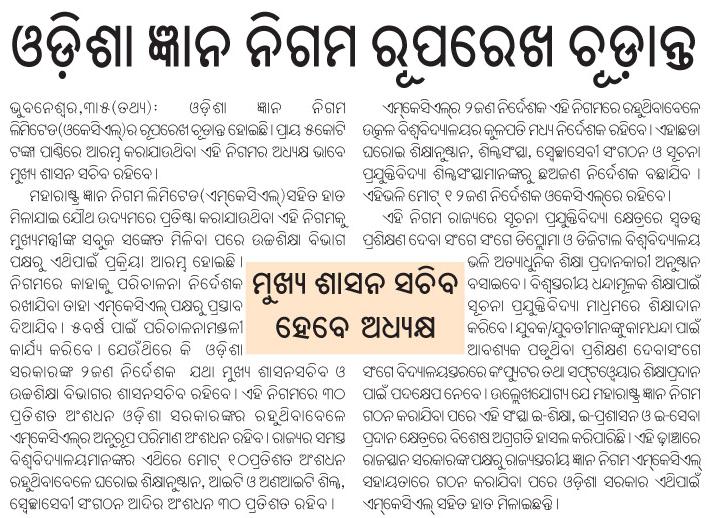
May 4th, 2011
The web page of this contest is at http://settlement.arc.nasa.gov/Contest/. The results of the 2011 page is at http://settlement.arc.nasa.gov/Contest/Results/2011/index.html. Following are excerpts from that web page.
Winners
Grand Prize
The Grand Prize for the 2011 Space Settlement Contest went to a large team of 7 students (11-12 grade), Gaurav Kumar, Deepak Talwar, Harman Jot Singh Walia, Mahiyal B. Singh, Kaenat Seth, Ishaan Mehta, and Navdeep Singh Makkar, from Punjab, India for creating the Hyperion Space Settlement. They also won the NSS Bruce M. Clark, Jr. Memorial Space Settlement Award.
First Prize
11-12 Grade First Prize
- Asteria, Sarah Bell, Queensland, Australia, Individual.
- Shangri-la, Odisha, India (Delhi Public School), Small Team.
- CRONOS, Constanta, Romania (Colegiul National "Mircea cel Batran"), Large Team.
9-10 Grade First Prize
- Adamas, Aditya Bathla, Punjab, India (Apeejay School), Individual.
- AMOS (Advanced Moon Orbiting Settlement), Romania ("Tudor Vianu" National High School of Computer Science), Small Team.
- Brisinger, Constanta, Romania (Colegiul National "Mircea cel Batran"), Large Team.
6-8 Grade First Prize
- The Satus Novo Serere, Hasan N. Kahn, Riyadh, Saudi Arabia (American International School), Individual.
- Big Bang, California, USA (Sequoia Middle School), Small Team.
- EON: Everlasting Orbita Nation, New York, USA (Cortland Junior Senior High School), Large Team.
Specialty First Prize
- S’ukhavati, Mrinal Chaudhury, Odisha, India (Delhi Public School), Artistic Merit.
- Life on the Space Station, Seebor, Romania (Tudor Vianu National High School of Computer Science), Literary Merit.
- Arcadia, Shanghai, China, Life Sciences.
Rourkelacity.com has some details about the winners. Following are some excerpts.
Among the winners include the team comprising Siddharth Tripathi, Akshat Dutt and Nisarg Behera of class –XII, and Mrinal Chaudhary of class-VIII of the same school.
The team comprising Siddharth, Akshat and Nisarg won the first prize in the 11th -12th grade for their project titled “Sangri-La”, a space settlement colony to provide exceedingly proficient and enjoyable living amenities for 20,000 permanent space residents. The colony that the team has proposed, is designed as a heavenly abode for settlers who can revel in the extraordinary luxury away from the earth. Thinking out of the box, the team proposed a major scientific research laboratory as well as a business hub in space, bio-regenerative life systems incorporating all biological components, state of art meditation halls, an efficiently functioning government machinery to take care of the law and order, a new currency named ‘Hawking’ and also a National Shangri-La Stock Exchange to help people participate in World economic affairs.
Mrinal won the specialty first prize for Artistic merit in her paper presentation titled “Sukhavati”. Mrinal in her report presented the colony and several paintings and diagrams depicting the interior and the exterior, living spaces, laboratories, recreation areas etc. of the colony.
… Mr.Bijoy Bahadur Mathur, Science Head of the School and the mentor to these students has been instrumental in preparing the students for this competition.
Teams from Odisha have been doing very well in this contest for the last several years.
April 26th, 2011
The website of SIRD is http://www.sirdorissa.org/. See also http://orissa.gov.in/panchayat/SIRD/sird1.htm. Following is a list of training institutes in Odisha listed in a SIRD document.
- Institute of Agricultural Management, Bhubaneswar
- Gram Sevak Talim Kendra (GSTK), Bolangir
- Gram Sevak Talim Kendra (GSTK), Ganjam
- Gram Sevak Talim Kendra, Dhenkanal
- Minor Irrigation and Water Use (MIWU), Bhubaneswar
- Plant Protection Training Institute (PPTI), Bhubaneswar
- Soil Conservation Training Institute (SCTI), Koraput
- School of Horticulture (SHC), Khurda
- Orissa State Co-operative Union (OSCU), Bhubaneswar.
- Co-operative Training Centre (CTC), Ganjam
- Krutartha Acharya Co-operative Training Institute(KACTI),Baragarh
- Revenue Inspectors Training Institute (RITI), Ganjam
- Co-operative Training Institute (CTI), Mayurbhanj.
- Co-operative Training Institute (CTI), Koraput
- Home Economics Training Centre (HETC), Bhubaneswar.
- Home Economics Training Centre (HETC), Barpali, Sambalpur
- Madhusudan Institute of Co-operative Management (MICM), Bhubaneswar
- Crew Training Institute (CRTI), Chandabali, Bhadrak
- School of Printing and Allied Trades (SPAT), Cuttack
- Driving Training School (DRTS), Bhubaneswar.
- Secondary Council Education Research Training (SCERT),Bhubaneswar
- Madhusudan Institute of Accounts & Finance (MIAF), Bhubaneswar
- Rangers Training College (RTC), Angul
- Nocholoson Forest School (NFS), Keonjhar
- Muny Forest Guards School, Dhenkanal
- Forest Training School (FTS), Phulbani
- Forester’s Training School (FTS), Jeypore
- Social Forestry Training School (SFTS), Bhubaneswar
- Fisheries Training Institute (FTI), Balugoan
- Live Stock Inspectors Training Institute (LSITI), Bhanjanagar
- L I Training Institute(LITI), Bolangir
- Live Stock Training Institute (LSTI), Keonjhar
- College of Nursing (CN), Berhempur, Ganjam
- Health & Family Welfare Training Centre(HFWTC), Cuttack
- Regional Institute of Planning,Applied Economics& Statistics(STI),BBSR
- SC & ST Training Institute, Bhubaneswar
- Secretariat Training Institute (SECTI), Bhubneswar
- Police Training College (PTC), Angul
- Orissa Shorthand and Type-writing Trg. Institute(OSTWTI), Bhubaneswar
- Fire Service Training School (FSTS), Bhubaneswar
- Municipal Training Institute (MTI), Bhubaneswar
- Public Health (PH), Bhubaneswar
- Sericulture (S), Keonjhar
- I I F T, Sundergarh
- Master Craftsmen Training Institute (MSTI), Bhubaneswar
- Water and Land Management Institute (WALMI), Cuttack
- Gopabandhu Academy of Administration, Bhubaneswar.
- Veterinary Officers Training Institute (VOTI), Bhubaneswar
- Extension Training Centre, Bhawanipatna.
- Extension Training Centre, Keonjhar
- Extension Training Centre, Bhubaneswar.
April 7th, 2011
Previous Posts






